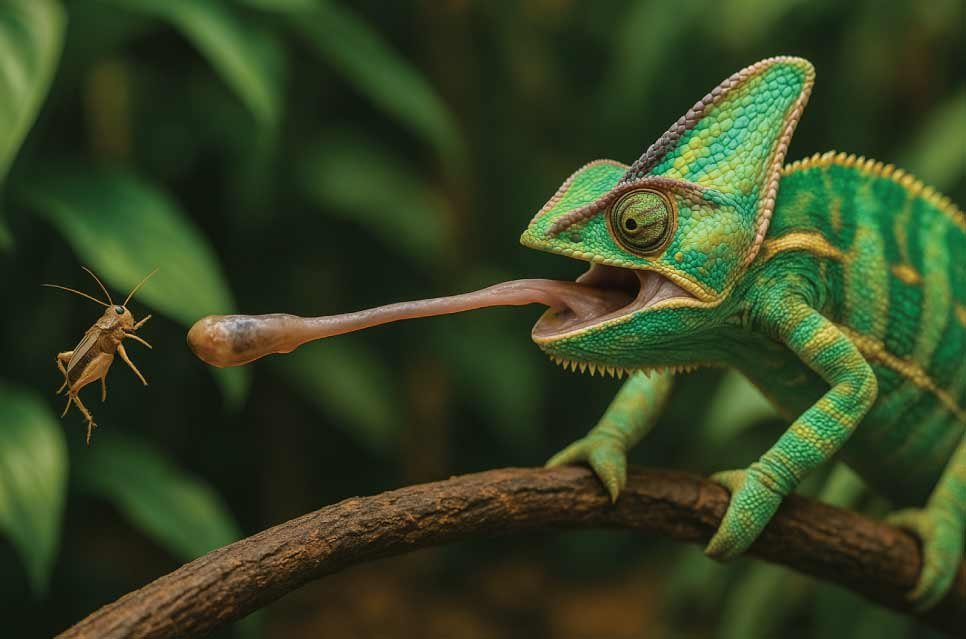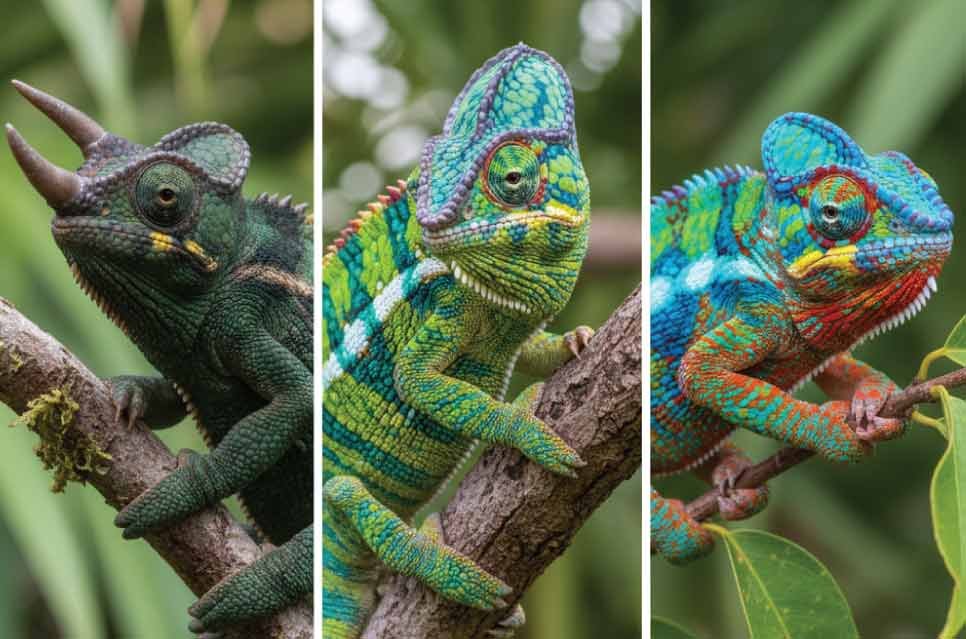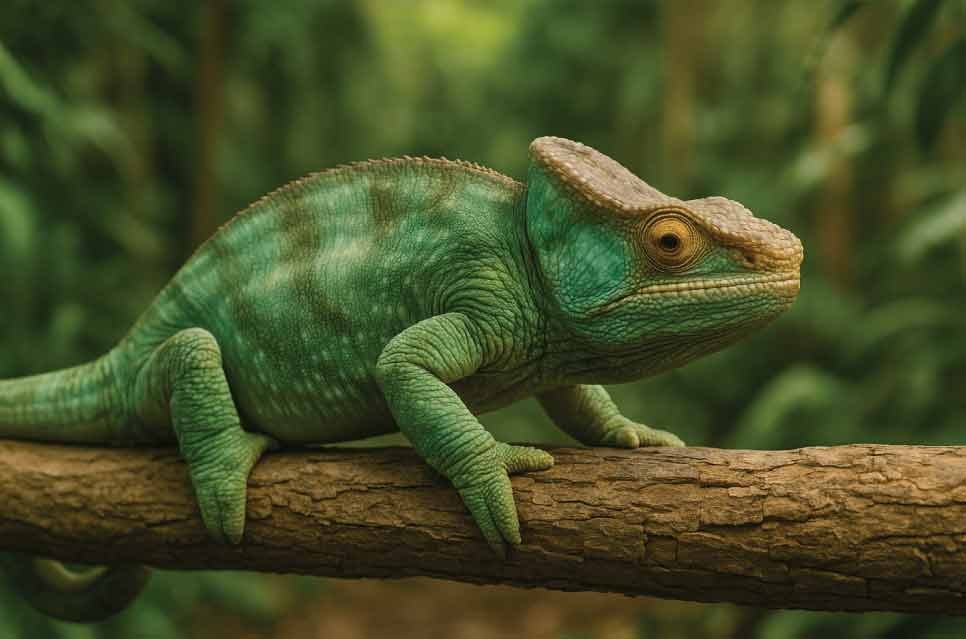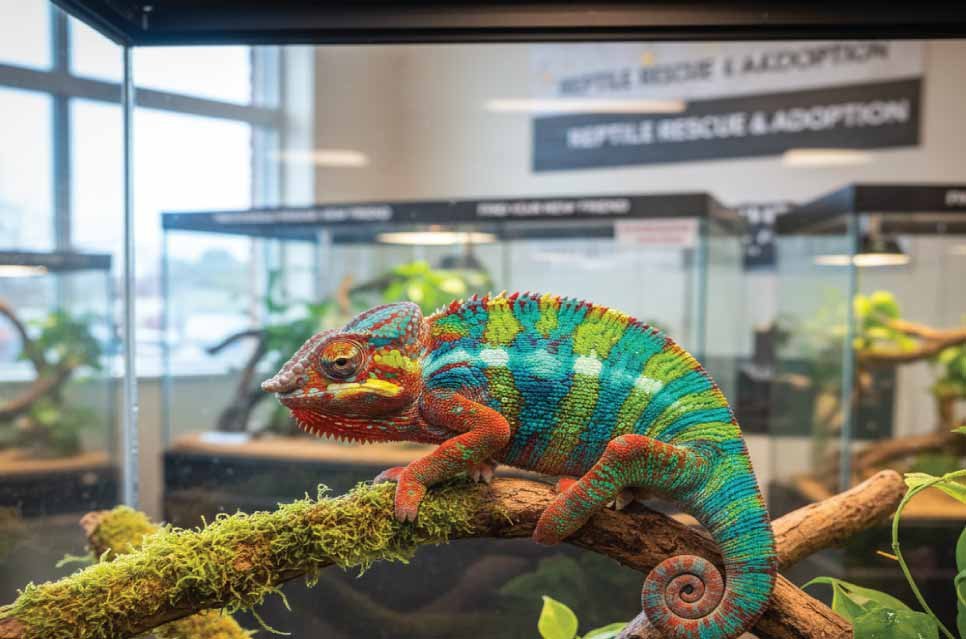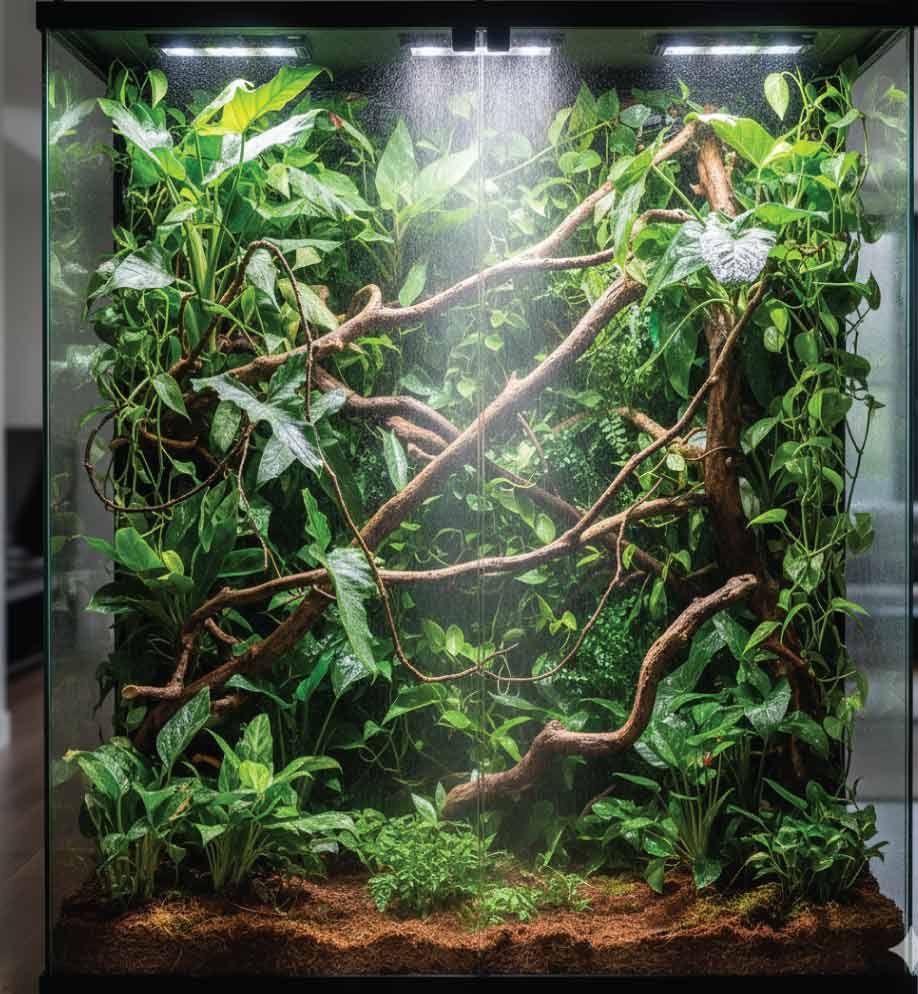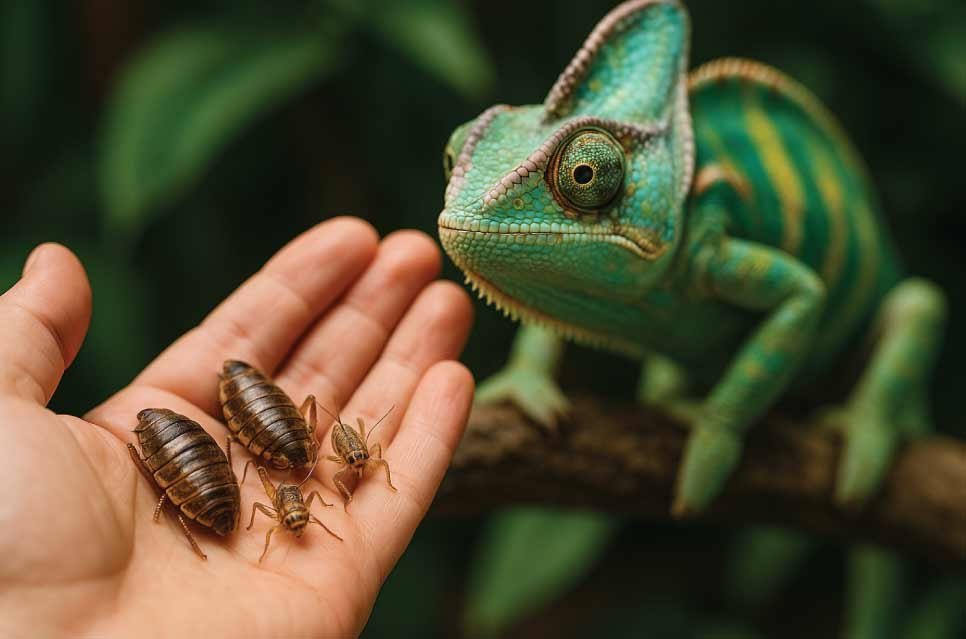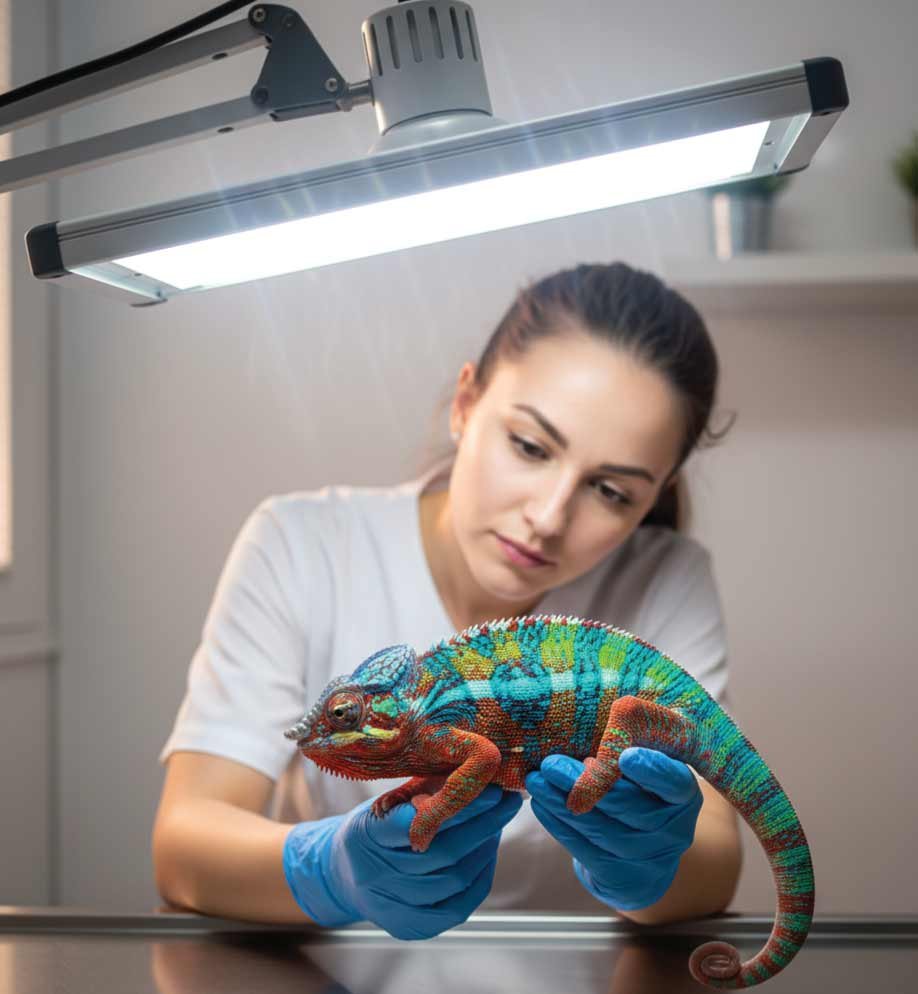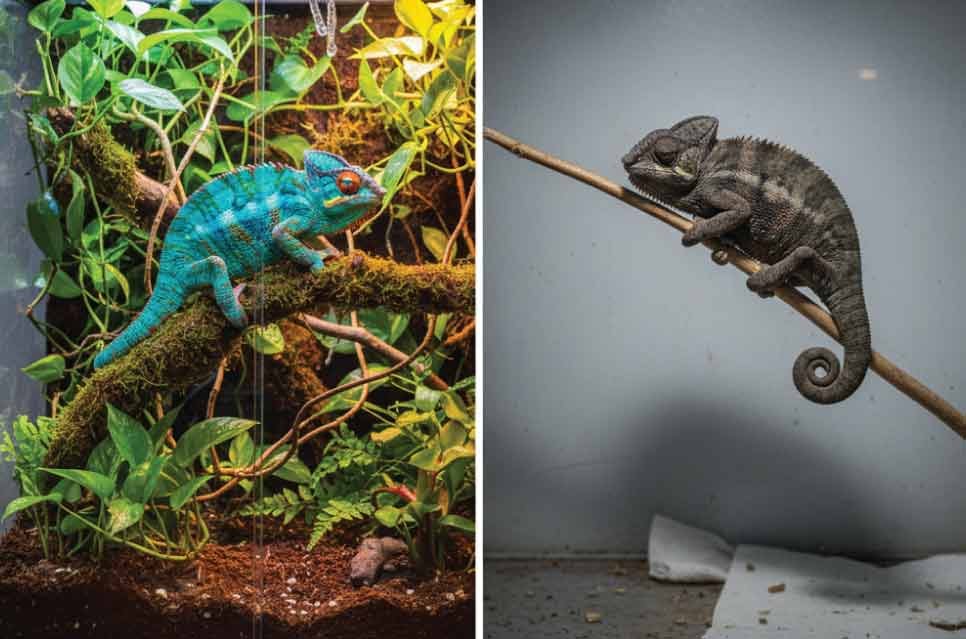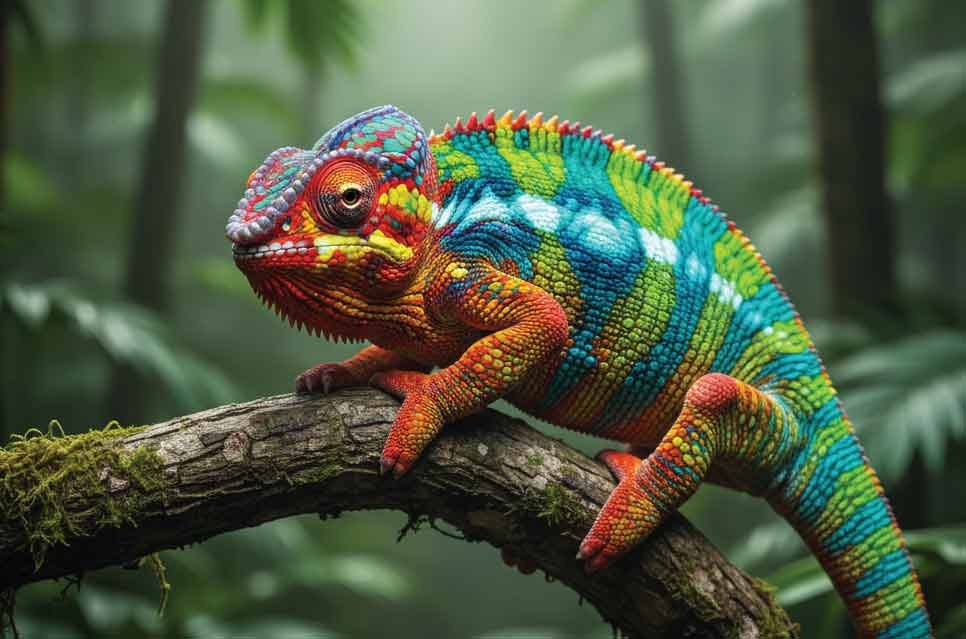There’s something almost magical about watching a chameleon in action. One moment, it’s perfectly camouflaged against a leafy branch, the next it’s launching its long, lightning-fast tongue to snatch a cricket mid-air. Add in their dazzling ability to shift colors and their preference for lush, vertical habitats, and suddenly your home terrarium feels like a slice of the rainforest.
But here’s the thing: chameleons aren’t the kind of pets you’ll cuddle on the couch or train to follow commands. Instead, they thrive as “observation pets,” much like an aquarium full of tropical fish. Their beauty lies in being admired from a distance, where they can live stress-free and display their natural behaviors.
If you’ve ever found yourself drawn to the quiet elegance of reptiles, you’ll want to understand what caring for a chameleon truly involves. And before you bring one home, it’s worth brushing up on responsible reptile ownership, because while they’re fascinating companions, they also come with very specific needs that every future keeper should know.
Listen to the Podcast: Are Chameleons Good Pets?
Are Chameleons Good Pets?
Chameleons are truly mesmerizing creatures to share your space with. Their gentle swaying movements, shifting colors, and unique hunting style can make every glance into their enclosure a small adventure. For the right person, that’s exactly the kind of companionship they’re looking for, quiet, calming, and endlessly fascinating.
Pros of keeping a chameleon:
- They’re captivating to watch, with natural behaviors you won’t see in more common pets.
- They don’t need constant interaction, which means they’re low-maintenance in terms of handling.
- With the right bioactive setup of plants, branches, and vines, their enclosure can become a living piece of home décor.
Cons to keep in mind:
- Chameleons are not affectionate or trainable like dogs or cats. If you’re hoping for snuggles or playtime, they won’t meet that need.
- They require a steady supply of live insects, crickets, Dubia roaches, grasshoppers, and mealworms. For some people, managing bugs can feel more like a chore than a joy.
- Improper care or over-handling can easily stress them, leading to health issues.
Here’s a tip many new keepers wish they knew sooner: maintain your own feeder insect colony. This way, you’ll always have fresh, gut-loaded insects on hand, which improves your chameleon’s nutrition and saves you money over time. If raising insects isn’t your thing, you can order from reliable suppliers, but avoid freeze-dried or dead insects, as these can cause digestive blockages.
And while their diet is insect-heavy, some reptile parents also enjoy offering variety. If you’d like to get creative with enrichment, you can look into homemade treats for your reptile, though insects will always remain the core of your chameleon’s meals.
Bottom line? Chameleons make wonderful pets for observant owners who are more interested in watching nature unfold than seeking physical affection. They’re best suited for patient, detail-oriented pet parents who don’t mind daily care routines, and who don’t flinch at the thought of a cricket or two hopping around.
Types of Chameleons: Choosing the Right One
Not all chameleons are the same, and choosing the right species can make or break your experience as a new reptile parent. Each type varies in size, temperament, and care requirements, so it’s important to find a match that fits both your lifestyle and your level of reptile-keeping experience.
Here are some of the most popular species you’ll come across:
- Jackson’s Chameleon – Known for their striking horns and hardy nature, these chameleons are often a good choice for beginners willing to learn the ropes.
- Veiled Chameleon – Bold, active, and covered in vivid patterns. They’re affordable but can be territorial, which means they’re best kept solo.
- Panther Chameleon – Famous for their jaw-dropping colors. They’re larger and need more space, making them better for keepers with some reptile experience.
- Carpet Chameleon – Smaller and often more ground-dwelling than arboreal. While beautiful, their unique needs can be trickier for beginners.
- Four-Horned Chameleon – With their unusual look, they’re eye-catching, but their care level is moderate, best for someone who already understands reptile basics.
- Parson’s Chameleon – Giants of the chameleon world, with lifespans that can stretch 20+ years. They’re amazing to watch but definitely suited only for advanced keepers.
- Pygmy Chameleon – Tiny and adorable, but sadly short-lived. Their size and lifespan mean they’re not the best choice if you’re looking for a long-term companion.
💡Tip: Before bringing home any chameleon, always check whether the species is legal to own in your area and if CITES paperwork is required. This ensures your pet is ethically sourced and protects wild populations.
Some species are easier for first-time reptile parents than others, just like you’d weigh when asking what is the best reptile to have as a pet.
Chameleon Lifespan
One of the most important things to know before adopting a chameleon is that their lifespans vary dramatically depending on the species and the care they receive. While some only live a year or two, others can stay with you for decades, making them a serious long-term commitment.
Here’s a quick look at average lifespans and price ranges for some popular species:
| Species | Lifespan | Price Range |
|---|---|---|
| Jackson’s | 3–5+ years | $65–$150 |
| Veiled | 6–8+ years | $30–$190 |
| Panther | 3–6+ years | $130–$380 |
Larger species like the Parson’s Chameleon can live 20 years or more when cared for properly. That means you’re not just committing to an exotic pet, you’re committing to years of daily feeding, misting, and habitat maintenance.
Want to help your chameleon live as long and healthy as possible? Check out these reptile health tips to learn about lighting, nutrition, and preventative care that make all the difference
Where to Buy: Sourcing Responsibly
When it comes to welcoming a chameleon into your life, where you get your pet matters just as much as how you care for them. Sadly, many chameleons in pet shops are wild-caught. These animals often arrive stressed, dehydrated, and carrying parasites, which can shorten their lives dramatically.
For the healthiest start, it’s best to choose captive-bred chameleons from reputable breeders. Captive-bred individuals are more likely to adapt well to life in a home enclosure and less likely to spread diseases. After purchase, always schedule a check-up with a reptile-savvy veterinarian, especially if you’re unsure of their origins.
But here’s something close to my heart: whenever possible, consider adopting or fostering a chameleon that needs a second chance. Just like with dogs or cats, reptiles can end up in rescues or foster homes when their first owners realize they can’t keep up with the care. Giving one of these animals a safe and stable home not only saves a life but also supports more ethical, compassionate pet ownership.
And remember, ethical sourcing isn’t just about your peace of mind. It helps protect wild populations and encourages better practices in the reptile trade. For more background, you can read about responsible reptile ownership and how small choices make a big impact on animal welfare.
Habitat Setup
Chameleons are tree-dwellers by nature, which means their enclosures need to reach high instead of spreading wide. Think “mini rainforest” rather than “glass box.” A tall, well-planted habitat is the key to keeping your chameleon stress-free and active.
Minimum enclosure sizes
- Large species (like Panther or Veiled): at least 3’L x 3’W x 4’H
- Smaller species (like Carpet or Jackson’s): at least 18”L x 18”W x 30”H
Bigger is always better, your chameleon will use every inch of vertical space.
Essentials for every setup
- Lighting & Heat: A strong UVB bulb and a basking lamp, both on a timer to mimic a 12-hour day/night cycle.
- Climbing Structure: Live plants, vines, and branches that create hiding spots and pathways.
- Humidity & Water: Automated misters, drippers, a hygrometer, and a thermometer to keep humidity between 50–80%.
- Placement: Keep the enclosure high up (7–8 feet total height is ideal) and away from drafts or direct air vents.
Some keepers love creating bioactive setups, enclosures with live plants, soil, and cleanup crews like isopods and springtails. These can make maintenance easier, but they still require careful monitoring of humidity and hygiene.
💡 Pro tip: Many new reptile parents underestimate the importance of proper setup. To avoid costly mistakes, take a look at top reptile habitat mistakes beginners make (and how to avoid them). Getting it right from the start will make your chameleon’s life (and yours) so much smoother.
Feeding
When it comes to diet, chameleons are strict insectivores. That means live bugs, every single time. Watching them snap up prey with their long, sticky tongues is thrilling, but it also means you’ll need to be comfortable handling insects on a regular basis.
What to feed
- Staples: Crickets, Dubia roaches, grasshoppers, superworms, and mealworms.
- Preparation: Always “gut-load” feeder insects with fresh veggies and fruits 24 hours before offering them. This boosts their nutritional value and helps prevent deficiencies.
- Supplements: Dust insects with calcium powder (daily for juveniles, a few times a week for adults) and add a multivitamin once or twice a month.
Feeding schedule
- Juveniles: Every day.
- Adults: About 4–5 times per week.
Chameleons don’t recognize standing water, so hydration comes from misting and drip systems. Automated misters make life easier, but you’ll still need to monitor humidity and hydration daily.
💡 If you want to mix things up and give your chameleon a little enrichment, you can look into homemade treats for your reptile. While insects will always be the main diet, creative feeding can keep things engaging and fun for both of you.
One big rule to remember: never offer freeze-dried or dead insects. They lack nutrition and can cause impaction (a dangerous gut blockage). Stick to live, moving prey for a healthy, active chameleon.
Health and Veterinary Care
Even with the best setup and diet, chameleons can run into health problems if their environment isn’t just right. Catching issues early is the key to keeping them thriving.
Common health concerns
- Metabolic Bone Disease (MBD): Caused by poor UVB lighting or lack of calcium, leading to weak, deformed bones.
- Dehydration: Shows up as sunken eyes, lethargy, or sticky saliva.
- Parasites: More common in wild-caught individuals but can also occur with contaminated feeder insects.
How to prevent issues
- Use high-quality UVB bulbs and replace them every 6–12 months (even if they still look like they work).
- Stick to a consistent misting and hydration routine.
- Quarantine new reptiles or insects before introducing them to your setup.
- Feed a gut-loaded, supplemented diet.
💡 Tip: Make regular visits to an exotic vet part of your care routine, especially if you’re new to reptile ownership. Subtle changes, like dull coloration or decreased appetite, can signal bigger health concerns.
For more advice on spotting problems before they get serious, check out these reptile health tips. A little prevention goes a long way in ensuring your chameleon enjoys a long, vibrant life.
Overall Pros and Cons
Chameleons are undeniably fascinating pets, but they’re not the right match for everyone. Here’s a quick look at the good and the not-so-good sides of keeping one at home:
| Aspect | Pros | Cons |
|---|---|---|
| Interaction | Low-effort joy of watching them behave naturally | No bonding or handling; solitary pets |
| Maintenance | Creative, rewarding enclosure setups | Daily misting, feeding, and monitoring required |
| Cost | Affordable entry species available | Ongoing expenses for insects, bulbs, and vet care |
| Appeal | Exotic, educational, and visually stunning | Requires comfort with insect handling; long commitment |
In short: chameleons can be amazing companions if you enjoy observation and routine care, but they aren’t pets you’ll snuggle or teach tricks.
If you’re curious about how they compare to other scaly friends, you might also enjoy reading Amphibians vs Reptiles. It’s a helpful way to see where chameleons fit into the bigger picture of exotic pet keeping.
Key Takeaways and Advice
Chameleons are best suited for observant, research-driven owners who love watching nature unfold. They’re not interactive pets, but they offer something just as special: the daily wonder of color changes, graceful movements, and unique hunting behaviors.
If you’re considering one, keep these points in mind:
- Match the species to your lifestyle, start with a hardier beginner-friendly chameleon if you’re new to reptiles.
- Choose ethical sources: captive-bred or adoption/foster care whenever possible.
- Invest in the right habitat from the beginning. A proper setup is half the battle to keeping your chameleon healthy.
- Commit to a routine, feeding, misting, lighting, and regular vet care are all part of their daily needs.
Above all, education is everything. Poor care is the number one reason chameleons don’t live as long as they should. Taking time to research and prepare will reward you with a thriving, beautiful pet that feels like a living piece of the rainforest right in your home.
👉 Ready to keep learning? Explore more in our Reptiles category for tips, care guides, and inspiration to make your reptile journey a success.
Are Chameleons Good Pets? Frequently Asked Questions (FAQs)
Chameleons don’t bond with humans the way cats or dogs do. They may become accustomed to your presence and feel less stressed when you’re around, but they don’t recognize owners in an affectionate sense. Their comfort level mostly comes from consistent, calm care and a stable environment.
No, chameleons are solitary by nature and can become highly stressed or aggressive when housed together. Even males and females should not be kept together outside of breeding situations. Each chameleon needs its own dedicated enclosure.
Spot-clean daily by removing uneaten insects and waste. A deeper clean of branches, plants, and substrate is usually needed every 2–4 weeks. If you have a bioactive setup, the cleanup crew (like isopods and springtails) will help reduce how often you need to deep-clean.
Chameleons are not ideal for kids. They don’t like to be handled, can become stressed easily, and require precise habitat conditions that are challenging for children to manage. They’re better suited for adults or teens who are already responsible pet keepers.
Signs of stress include dull or dark coloration, excessive hiding, refusing food, or pacing the enclosure. Stress can come from overhandling, improper temperatures or humidity, or seeing another chameleon nearby. If you notice these signs, reassess their setup and care routine.
Yes! While many chameleon keepers prefer breeding Dubia roaches or crickets at home for convenience, you can also order feeders from reputable online suppliers. Just make sure the insects arrive alive, are gut-loaded, and come from a trusted source. Avoid buying from unreliable pet shops where quality may be poor.


